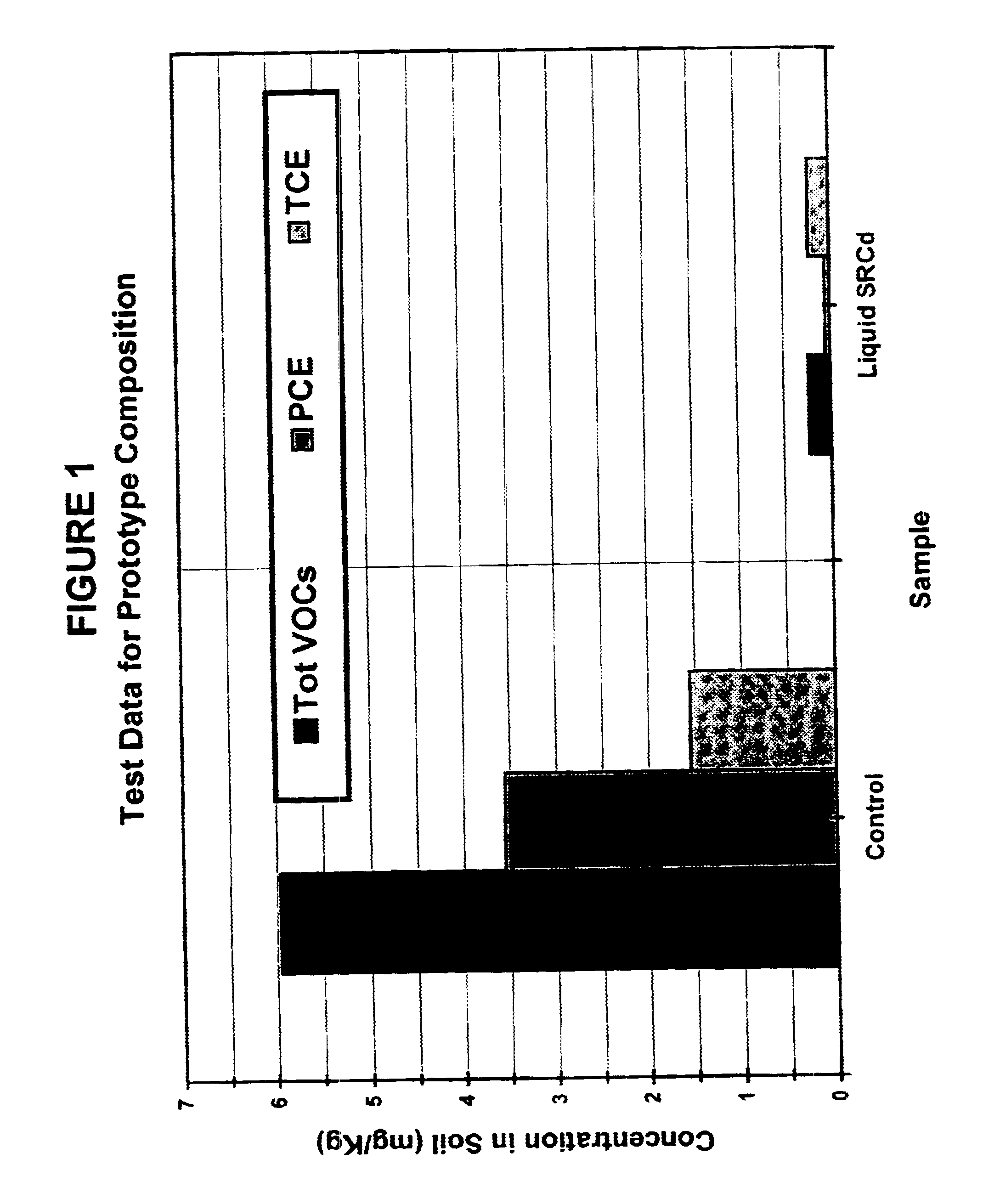Solid-chemical composition for sustained release of organic substrates and complex inorganic phosphates for bioremediation
a bioremediation and organic substrate technology, applied in the direction of biological water/sewage treatment, inorganic carrier, enzymology, etc., can solve the problems of toxic, carcinogenic or potentially carcinogenic to humans, many of these contaminants tend to persist, and the soot and groundwater pollution caused by chemical contaminants released into the environment, etc., to increase the bioavailability of hydrophobic organic contaminants, enhance the above-mentioned bioremediation process, and increase the speed of environmental remedi
- Summary
- Abstract
- Description
- Claims
- Application Information
AI Technical Summary
Benefits of technology
Problems solved by technology
Method used
Image
Examples
example 1
Bench-scale experiments were conducted to evaluate the effectiveness of the application of several liquid-chemical compositions to fine-grained soils contaminated with a mixture of chlorinated solvents and hydrocarbons from a contaminated industrial site. The most effective liquid-chemical composition, a prototype of the present invention, reduced the total levels of chlorinated solvent compounds by as much as 96% relative to the experimental control and baseline samples. This prototype composition included a combination of molasses, granulated organic brown sugar, sodium carboxymethyl cellulose and sodium hexametaphosphate.
Noteworthy was that the contaminated soils treated with the prototype composition comprised a very-low permeability, putty-like silty clay; hence, the diffusion-driven flux of the substrates and amendments included in the prototype composition was believed to have been an important factor in the success of these experiments. Concentrations of total chlorinated co...
example 2
The inventor has successfully manufactured granulated and briquetted forms of a number of different embodiments of the disclosed solid-chemical compositions of the present invention using a Fitzpatrick Model IR 520 Chilsonator System, including a Model M5A granulator. The Model IR 520 Fitzpatrick Chilsonator system is a small-scale version of larger Fitzpatrick briquetting and granulation systems, and is typically used for small-scale production runs and prototype tests, the results of which can be scaled to larger Fitzpatrick Chilsonator systems.
The briquetted and granulated embodiments of the present invention which were successfully produced with the Fitzpatrick Chilsonator system included the solid-chemical compositions designated as the "3" through "8" series "substrate-release compositions" or "SRC." The embodiments of the present invention produced with the Fitzpatrick Chilsonator system included a broad range of the formulated proportions of the soluble organic substrates an...
example 3
A field-scale demonstration was initiated in September 2000 to test the application of a combination of three different, preferred embodiments of the solid-chemical compositions disclosed herein to treat chlorinated solvents present in ground-water at an industrial site. These embodiments were designated as the "SRC-4," "SRC-5" and "SRC-6" series compositions. Each of the three preferred embodiments of the disclosed compositions was prepared in granular form using the Fitzpatrick Model IR 520 Chilsonator System, including a Model M5A granulator. Each of the compositions included different proportions of soluble and insoluble organic substrates, and included different combinations of powdered molasses, granulated organic brown sugar, citric acid, sodium carboxymethyl cellulose, cellulose powder, powdered insoluble starch / flour, alfalfa meal, and complex inorganic phosphates (primarily comprised of sodium hexametaphosphate).
On Sep. 28, 2000, 10 lbs. of each of the three granulated com...
PUM
| Property | Measurement | Unit |
|---|---|---|
| weight percent | aaaaa | aaaaa |
| weight percent | aaaaa | aaaaa |
| weight percent | aaaaa | aaaaa |
Abstract
Description
Claims
Application Information
 Login to View More
Login to View More - R&D
- Intellectual Property
- Life Sciences
- Materials
- Tech Scout
- Unparalleled Data Quality
- Higher Quality Content
- 60% Fewer Hallucinations
Browse by: Latest US Patents, China's latest patents, Technical Efficacy Thesaurus, Application Domain, Technology Topic, Popular Technical Reports.
© 2025 PatSnap. All rights reserved.Legal|Privacy policy|Modern Slavery Act Transparency Statement|Sitemap|About US| Contact US: help@patsnap.com


